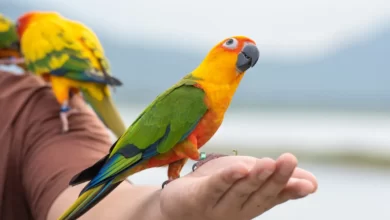Where Do Parrots Live? An In-Depth Exploration
Parrots are among the most colorful and intelligent birds on the planet, renowned for their vivid plumage and remarkable ability to mimic sounds.
Understanding where parrots live requires delving into their diverse habitats, which span across continents and climates. This blog will provide an expert examination of the habitats of parrots, covering regions from tropical rainforests to temperate woodlands. We will also explore how these habitats influence their behavior, diet, and survival strategies.
Introduction to Parrot Habitats
Parrots, belonging to the order Psittaciformes, are primarily found in the Southern Hemisphere, though some species inhabit regions north of the equator. Their habitats are incredibly diverse, ranging from dense tropical forests to arid savannas. The distribution of parrots is heavily influenced by climate, availability of food, and nesting sites. Here is a summary of the various habitats where parrots thrive:
- Tropical Rainforests: Home to the largest variety of parrot species.
- Savannas and Grasslands: Adapted to open, semi-arid environments.
- Temperate Woodlands: Found in regions with moderate climates.
- Mangroves and Coastal Regions: Specialize in coastal ecosystems.
- Islands and Archipelagos: Endemic species with unique adaptations.
Summary Table: Parrot Habitat Types
| Habitat Type | Key Characteristics | Example Species |
|---|---|---|
| Tropical Rainforests | Dense vegetation, high biodiversity | Scarlet Macaw, Amazon Parrots |
| Savannas and Grasslands | Open areas, scattered trees, seasonal rainfall | Cockatoos, African Grey Parrots |
| Temperate Woodlands | Moderate climate, mixed forests | Kea, Red-fronted Parakeet |
| Mangroves and Coastal Regions | Coastal trees and shrubs, tidal influence | Mangrove Parrot, Thick-billed Parrot |
| Islands and Archipelagos | Isolated, unique flora and fauna | Kakapo, Echo Parakeet |
Tropical Rainforests
Overview
Tropical rainforests are the most species-rich habitats on Earth and are crucial for the survival of many parrot species. These forests provide a continuous canopy that offers food, shelter, and nesting sites. The warm, moist climate supports a year-round abundance of fruits, nuts, seeds, and insects—key components of a parrot’s diet.
Key Regions
- Amazon Basin: The largest tropical rainforest, home to over 100 species of parrots.
- Central America: Dense forests in countries like Costa Rica and Panama.
- Southeast Asia: Rich biodiversity in countries like Indonesia and Malaysia.
Example Species
- Scarlet Macaw (Ara macao): Known for its bright red, yellow, and blue feathers, it inhabits the canopy layer.
- Amazon Parrots (Amazona spp.): Includes multiple species with varying colors and vocal abilities.
Habitat Characteristics
- Dense Canopy: Provides protection from predators and harsh weather.
- Epiphytes and Lianas: Support a rich ecosystem that parrots exploit for food and nesting.
- Seasonal Rains: Ensure a continuous supply of water and food resources.
Savannas and Grasslands
Overview
Savannas and grasslands are characterized by open landscapes with scattered trees and seasonal rainfall. These habitats require parrots to be highly adaptable, as they must cope with the dry and wet seasons.
Key Regions
- Africa: Particularly in the savannas of West and Central Africa.
- Australia: The Outback regions with open woodland and grassland areas.
- South America: The Brazilian Cerrado and Llanos of Venezuela.
Example Species
- Cockatoos (Cacatuidae): Known for their crests and loud calls, they inhabit Australia and parts of Indonesia.
- African Grey Parrot (Psittacus erithacus): Renowned for its intelligence and speaking ability, found in West and Central African forests and savannas.
Habitat Characteristics
- Scattered Trees: Offer nesting sites and perches.
- Grasslands: Provide seeds and insects as food sources.
- Seasonal Changes: Parrots must adapt to dry seasons with limited water.
Adaptations
- Nomadic Behavior: Moving to different areas to find food and water.
- Ground Foraging: Some species forage on the ground for seeds and insects.
Temperate Woodlands
Overview
Temperate woodlands offer a moderate climate with distinct seasons, supporting a variety of parrot species that have adapted to cooler temperatures compared to their tropical relatives.
Key Regions
- New Zealand: Unique temperate rainforests and woodlands.
- Australia: Southern temperate regions with mixed forests.
- Chile: Temperate forests in the southern part of the country.
Example Species
- Kea (Nestor notabilis): A large, intelligent parrot native to New Zealand’s South Island.
- Red-fronted Parakeet (Cyanoramphus novaezelandiae): Found in New Zealand, it adapts well to various forest environments.
Habitat Characteristics
- Mixed Forests: Composed of deciduous and evergreen trees.
- Seasonal Variation: Temperate woodlands experience cold winters and warm summers.
- Varied Diet: Parrots in these regions eat a mix of fruits, seeds, and small invertebrates.
Adaptations
- Thick Plumage: Provides insulation against cold temperatures.
- Seasonal Movements: Some species migrate to lower altitudes during winter.
Mangroves and Coastal Regions
Overview
Mangroves and coastal regions are specialized habitats where parrots have adapted to life along coastlines, often in areas influenced by tides and saltwater.
Key Regions
- Central and South America: Coastal mangroves from Mexico to Brazil.
- Southeast Asia: Extensive mangrove forests in Indonesia, Thailand, and Malaysia.
- Australia: Northern coastal regions with significant mangrove ecosystems.
Example Species
- Mangrove Parrot (Amazona rhodocorytha): Inhabits mangrove areas in Brazil.
- Thick-billed Parrot (Rhynchopsitta pachyrhyncha): Found in the coastal forests of Mexico.
Habitat Characteristics
- Tidal Influence: Mangroves are subject to changing water levels.
- Salt Tolerance: Parrots here have adapted to higher salt concentrations.
- Rich Biodiversity: These regions are home to a wide variety of food sources.
Adaptations
- Specialized Feeding: Ability to consume food that thrives in saline environments.
- Nest in Mangroves: Using the unique structure of mangrove trees for nesting.
Islands and Archipelagos
Overview
Islands and archipelagos provide unique habitats where parrots often evolve distinct characteristics due to geographic isolation. These areas can foster high levels of endemism.
Key Regions
- New Zealand: Islands with unique avian fauna.
- Madagascar: Home to species like the Grey-headed Lovebird.
- Caribbean Islands: Diverse parrot species adapted to island life.
Example Species
- Kakapo (Strigops habroptilus): A nocturnal, flightless parrot from New Zealand.
- Echo Parakeet (Psittacula eques): Endemic to Mauritius, it has made a remarkable recovery from near extinction.
Habitat Characteristics
- Isolated Ecosystems: Unique flora and fauna due to isolation.
- Limited Resources: Parrots must be highly adaptable to scarce resources.
- High Endemism: Species found nowhere else in the world.
Adaptations
- Flightlessness: Some island parrots, like the Kakapo, have lost the ability to fly due to the absence of predators.
- Specialized Diets: Adaptation to the specific plants and insects available on the islands.
Human Impact on Parrot Habitats
Overview
Human activities have significantly impacted parrot habitats. Deforestation, urbanization, and agriculture have led to habitat loss and fragmentation, posing major threats to parrot populations worldwide.
Key Issues
- Deforestation: Clearing forests for timber and agriculture.
- Urbanization: Expansion of cities into natural habitats.
- Climate Change: Altering habitats and food availability.
Example Regions Affected
- Amazon Rainforest: Large-scale deforestation for agriculture.
- Southeast Asia: Palm oil plantations replacing native forests.
- Australia: Urban sprawl impacting native bushland.
Consequences
- Loss of Biodiversity: Decline in parrot species and other wildlife.
- Fragmented Habitats: Isolation of populations, leading to genetic bottlenecks.
- Increased Conflict: More interactions with humans, leading to higher mortality rates.
Mitigation Strategies
- Protected Areas: Establishing reserves and national parks.
- Sustainable Practices: Promoting eco-friendly agriculture and forestry.
- Community Engagement: Involving local communities in conservation efforts.
Conservation Status Table
| Species | Conservation Status | Key Threats |
|---|---|---|
| Kakapo | Critically Endangered | Predation, habitat loss |
| Echo Parakeet | Endangered | Habitat loss, competition with invasive species |
| Scarlet Macaw | Least Concern (locally threatened) | Deforestation, pet trade |
| African Grey Parrot | Endangered | Habitat loss, trapping for pet trade |
Conservation Efforts and Protected Areas
Overview
Conservation efforts are crucial for the survival of parrot species. Various international and local organizations work tirelessly to protect these birds and their habitats.
Key Organizations
- World Parrot Trust: Dedicated to the conservation and welfare of parrots.
- BirdLife International: Works on global bird conservation, including parrots.
- Local NGOs: Various regional organizations focused on specific habitats and species.
Protected Areas
- Amazon Rainforest Reserves: Large tracts of protected land in South America.
- National Parks in Africa: Protected savannas and forests.
- Island Reserves: Special focus on island endemics like the Kakapo.
Success Stories
- Kakapo Recovery Program: Intensive management and breeding programs in New Zealand.
- Echo Parakeet Conservation: Successful increase in population numbers in Mauritius.
Challenges
- Funding: Conservation programs require substantial financial resources.
- Enforcement: Protecting areas from illegal activities.
- Climate Change: Adapting conservation strategies to changing environments.
Parrots inhabit a wide range of environments, from the lush canopies of tropical rainforests to the arid expanses of savannas and the unique ecosystems of isolated islands. Each habitat presents its own set of challenges and opportunities, shaping the behaviors and adaptations of these remarkable birds.
Human activities pose significant threats to these habitats, but through concerted conservation efforts, it is possible to protect and preserve the diverse parrot species that enrich our planet.
Seasonal Habitat Use Guide for Parrots
Understanding the seasonal movements and habitat use of parrots can aid in their conservation and care. Here’s a general guide for a few parrot species:
| Season | Tropical Rainforest Species (e.g., Scarlet Macaw) | Savanna Species (e.g., African Grey Parrot) | Temperate Woodland Species (e.g., Kea) |
|---|---|---|---|
| Winter | Stable habitat, food from fruits and seeds | Dry season, limited water, ground foraging | Migrate to lower altitudes, seek food |
| Spring | Breeding season, abundant food | Start of rainy season, increased activity | Nesting season, abundant resources |
| Summer | Abundant food, care for young | Rainy season, peak food availability | Stable habitat, abundant food |
| Autumn | Transition to dry season, food preparation | Dry season onset, forage and store food | Prepare for winter, find shelter |
By understanding and protecting the diverse habitats of parrots, we can ensure that these vibrant and intelligent birds continue to thrive in the wild for generations to come.





